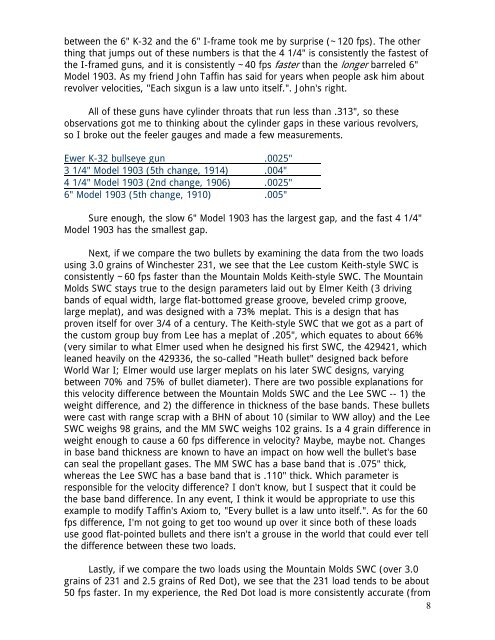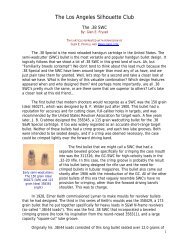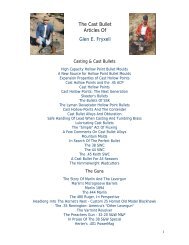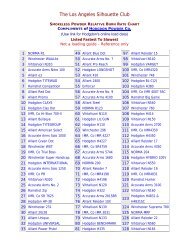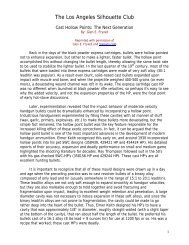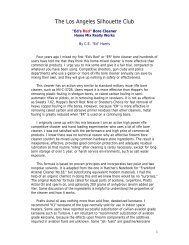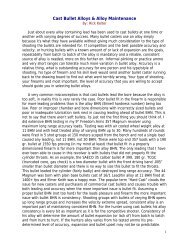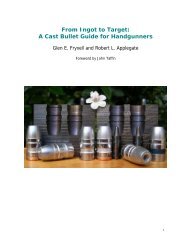The Los Angeles Silhouette Club - LASC Front Page
The Los Angeles Silhouette Club - LASC Front Page
The Los Angeles Silhouette Club - LASC Front Page
You also want an ePaper? Increase the reach of your titles
YUMPU automatically turns print PDFs into web optimized ePapers that Google loves.
etween the 6" K-32 and the 6" I-frame took me by surprise (~120 fps). <strong>The</strong> other<br />
thing that jumps out of these numbers is that the 4 1/4" is consistently the fastest of<br />
the I-framed guns, and it is consistently ~40 fps faster than the longer barreled 6"<br />
Model 1903. As my friend John Taffin has said for years when people ask him about<br />
revolver velocities, "Each sixgun is a law unto itself.". John's right.<br />
All of these guns have cylinder throats that run less than .313", so these<br />
observations got me to thinking about the cylinder gaps in these various revolvers,<br />
so I broke out the feeler gauges and made a few measurements.<br />
Ewer K-32 bullseye gun .0025"<br />
3 1/4" Model 1903 (5th change, 1914) .004"<br />
4 1/4" Model 1903 (2nd change, 1906) .0025"<br />
6" Model 1903 (5th change, 1910) .005"<br />
Sure enough, the slow 6" Model 1903 has the largest gap, and the fast 4 1/4"<br />
Model 1903 has the smallest gap.<br />
Next, if we compare the two bullets by examining the data from the two loads<br />
using 3.0 grains of Winchester 231, we see that the Lee custom Keith-style SWC is<br />
consistently ~60 fps faster than the Mountain Molds Keith-style SWC. <strong>The</strong> Mountain<br />
Molds SWC stays true to the design parameters laid out by Elmer Keith (3 driving<br />
bands of equal width, large flat-bottomed grease groove, beveled crimp groove,<br />
large meplat), and was designed with a 73% meplat. This is a design that has<br />
proven itself for over 3/4 of a century. <strong>The</strong> Keith-style SWC that we got as a part of<br />
the custom group buy from Lee has a meplat of .205", which equates to about 66%<br />
(very similar to what Elmer used when he designed his first SWC, the 429421, which<br />
leaned heavily on the 429336, the so-called "Heath bullet" designed back before<br />
World War I; Elmer would use larger meplats on his later SWC designs, varying<br />
between 70% and 75% of bullet diameter). <strong>The</strong>re are two possible explanations for<br />
this velocity difference between the Mountain Molds SWC and the Lee SWC -- 1) the<br />
weight difference, and 2) the difference in thickness of the base bands. <strong>The</strong>se bullets<br />
were cast with range scrap with a BHN of about 10 (similar to WW alloy) and the Lee<br />
SWC weighs 98 grains, and the MM SWC weighs 102 grains. Is a 4 grain difference in<br />
weight enough to cause a 60 fps difference in velocity Maybe, maybe not. Changes<br />
in base band thickness are known to have an impact on how well the bullet's base<br />
can seal the propellant gases. <strong>The</strong> MM SWC has a base band that is .075" thick,<br />
whereas the Lee SWC has a base band that is .110" thick. Which parameter is<br />
responsible for the velocity difference I don't know, but I suspect that it could be<br />
the base band difference. In any event, I think it would be appropriate to use this<br />
example to modify Taffin's Axiom to, "Every bullet is a law unto itself.". As for the 60<br />
fps difference, I'm not going to get too wound up over it since both of these loads<br />
use good flat-pointed bullets and there isn't a grouse in the world that could ever tell<br />
the difference between these two loads.<br />
Lastly, if we compare the two loads using the Mountain Molds SWC (over 3.0<br />
grains of 231 and 2.5 grains of Red Dot), we see that the 231 load tends to be about<br />
50 fps faster. In my experience, the Red Dot load is more consistently accurate (from<br />
8


